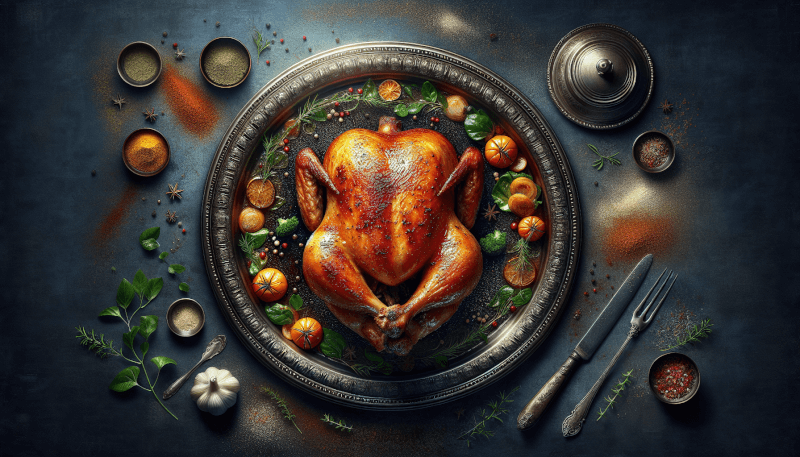In this article, you will discover the ultimate guide to creating the most mouthwatering, tender, and flavorful roast chicken you’ve ever tasted. Whether you’re a seasoned chef looking to perfect your techniques or a beginner in the kitchen, we’ve got you covered. From selecting the right bird to mastering the perfect combination of herbs and spices, you’ll learn all the tips and tricks to make your roast chicken the star of any meal. Get ready to impress your family and friends with your culinary skills!
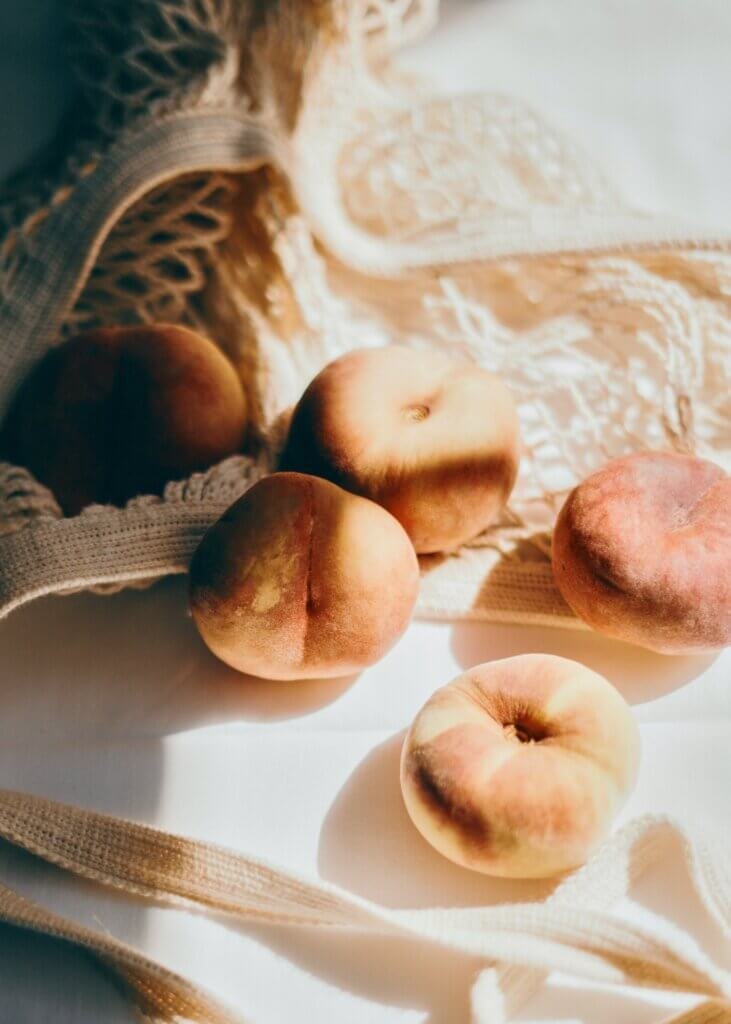
Choosing the Chicken
When it comes to making the perfect roast chicken, the first step is to choose the right chicken. There are a few factors to consider when selecting your bird.
Fresh vs. Frozen
Fresh or frozen, which one should you choose? While fresh chicken may seem like the obvious choice, frozen chicken can be a convenient and cost-effective option. Fresh chicken is typically juicier and more flavorful, but frozen chicken can still yield great results if cooked properly. If you opt for frozen chicken, make sure to thaw it thoroughly before cooking.
Size Matters
The size of your chicken is another important consideration. A larger bird may take longer to cook, while a smaller one might cook too quickly and dry out. A general rule of thumb is to aim for a chicken that weighs around 3-4 pounds. This size ensures that the chicken cooks evenly and stays moist throughout the roasting process.
Organic vs. Conventional
Whether to choose organic or conventional chicken is a personal preference. Organic chicken is raised without antibiotics or added hormones, and it is typically fed an organic diet. This can result in a slightly richer flavor and a more tender texture. However, conventional chicken can still produce delicious results if sourced from a reputable provider.
Preparation and Seasoning
Once you’ve chosen your chicken, it’s time to prepare and season it for roasting. Proper preparation and seasoning can greatly enhance the flavor and texture of your roast chicken.
Brining the Chicken
One technique to consider is brining your chicken. Brining involves soaking the chicken in a saltwater solution, which helps to tenderize the meat and infuse it with flavor. To brine your chicken, simply dissolve salt in water, submerge the chicken in the brine, and refrigerate for a few hours or overnight.
Trussing the Chicken
Trussing your chicken is another step that can contribute to a perfectly cooked bird. Trussing involves tying the legs and wings of the chicken with kitchen twine to help it maintain its shape and cook more evenly. While trussing is not absolutely necessary, it can help the chicken retain its moisture and result in a more uniformly cooked bird.
Seasoning Options
The seasoning options for roast chicken are endless. Some classic choices include salt, pepper, garlic powder, and paprika. You can also experiment with various herbs like rosemary, thyme, or sage. Don’t forget to season both the outside and inside of the chicken for maximum flavor. Be generous with your seasoning, but not overpowering, as you want the chicken’s natural taste to shine through.
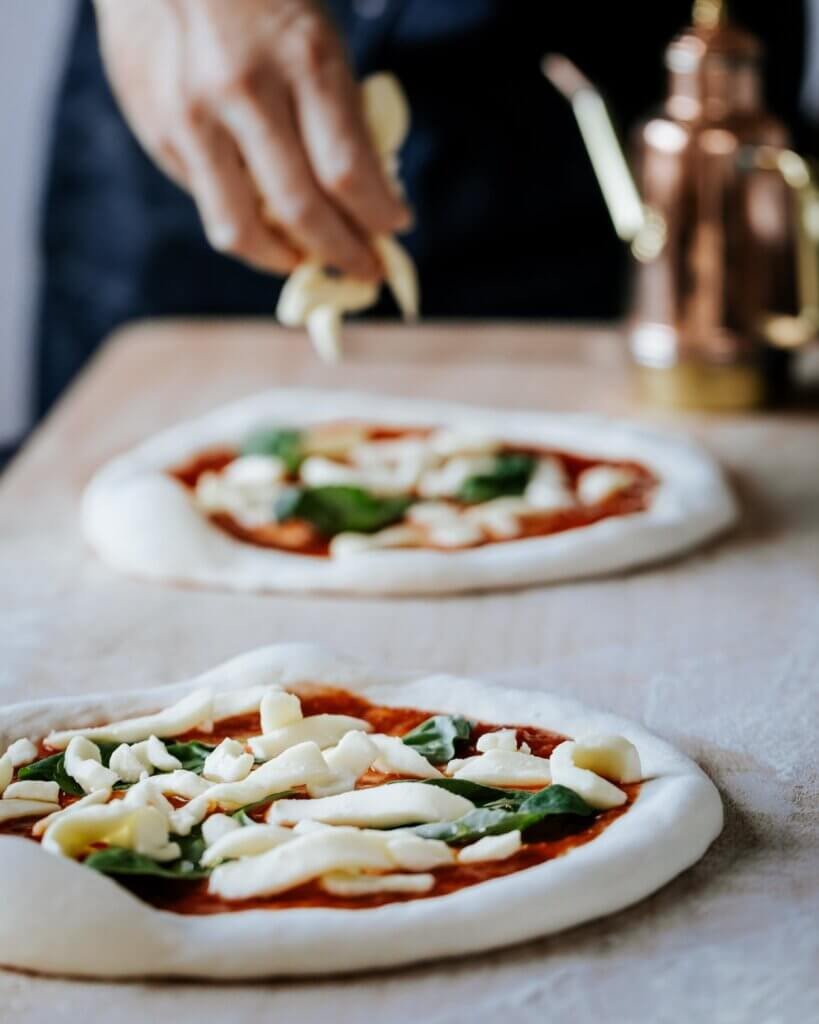
Cooking Techniques
Now that your chicken is prepared and seasoned, it’s time to choose the cooking technique that suits your preference.
Traditional Roasting
The traditional roasting method involves placing the chicken on a roasting rack in a preheated oven. This cooking technique allows the heat to circulate evenly, resulting in a juicy and evenly browned bird. It’s important to baste the chicken occasionally with its pan juices to enhance the flavor and moisten the meat.
High-Heat Roasting
For those seeking a crispy skin and succulent meat, high-heat roasting is the way to go. This technique involves starting the chicken at a high temperature to quickly brown and crisp the skin, then lowering the temperature to finish cooking it through. The high initial heat locks in the juices and creates a deliciously crispy exterior.
Spit-Roasting
If you have access to a rotisserie, spit-roasting can be an exciting option. This method involves skewering the chicken on a rotating spit and slowly cooking it over an open flame or in an oven. Spit-roasting allows for even cooking and results in a beautiful, evenly golden chicken with tender meat and a rich flavor.
Roasting Time and Temperature
To ensure your roast chicken is cooked to perfection, it’s important to determine the cooking time and internal temperature.
Determining Cooking Time
The cooking time for your roast chicken will depend on its size and the cooking technique you choose. As a general guideline, plan for about 15-20 minutes of cooking time per pound of chicken. However, it’s always best to rely on a meat thermometer to ensure your chicken is cooked through.
Ideal Internal Temperature
To ensure your chicken is cooked safely and to the desired doneness, it’s important to monitor its internal temperature. The ideal internal temperature for chicken is 165°F (74°C). Insert the meat thermometer into the thickest part of the chicken, away from the bone, to get an accurate reading.
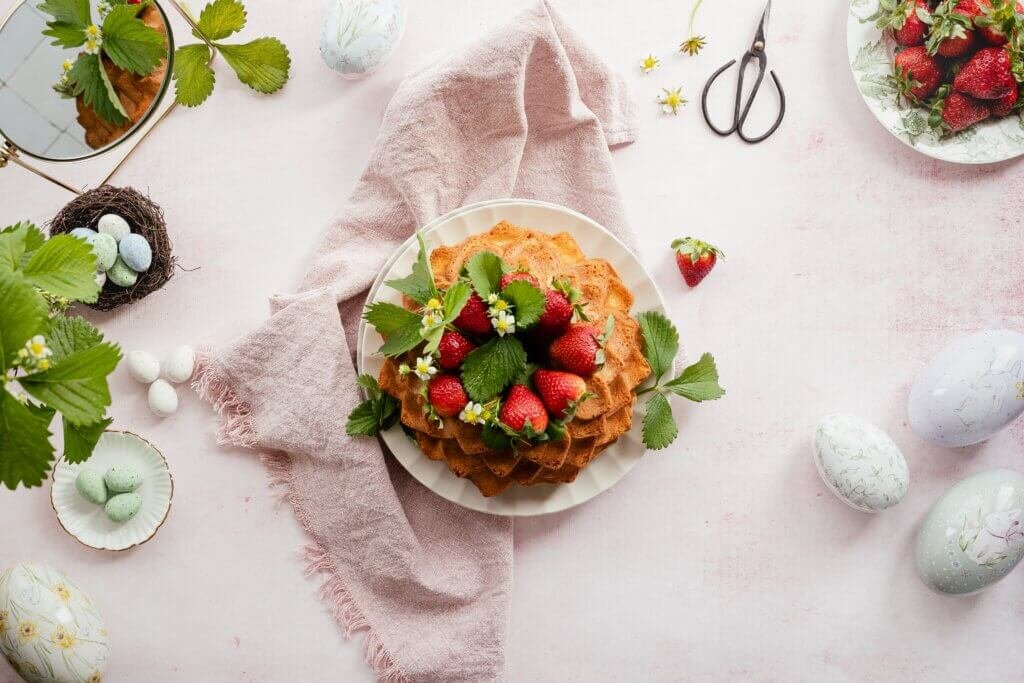
Enhancing Flavor with Aromatics
Aromatics are a great way to add depth and complexity to your roast chicken. Here are a few flavorful options to consider.
Garlic and Herb Butter
Mixing softened butter with garlic and your choice of herbs creates a delicious compound butter. Gently separate the skin from the chicken breast and carefully spread the compound butter underneath, ensuring even distribution. The butter will melt during cooking, infusing the meat with a rich, garlicky flavor.
Lemon and Thyme Infusion
A fresh and zesty flavor combination, lemon, and thyme can elevate your roast chicken to another level. Stuff the chicken cavity with lemon wedges and sprigs of thyme before roasting. As the chicken cooks, the lemon and thyme will infuse the meat with their refreshing flavors.
Onion and Rosemary Stuffing
For a savory twist, consider stuffing your chicken with a mixture of onions and rosemary. The onions add moisture and impart a subtle sweetness, while the rosemary lends a fragrant and earthy aroma. Simply stuff the cavity of the chicken with the onion and rosemary mixture before roasting.
Basting and Juicy Chicken
To ensure your roast chicken is juicy and full of flavor, basting is essential.
Basting Techniques
Basting involves periodically spooning the pan juices over the chicken during the cooking process. This not only adds moisture to the chicken but also helps to enhance the flavor. An easy way to baste is to use a basting brush or a spoon to scoop up the pan juices and gently brush or drizzle them over the chicken.
Pan Juices and Gravy
The pan juices that accumulate during the cooking process are a treasure trove of flavor. To make a delicious gravy, simply pour the pan juices into a saucepan and bring them to a simmer. Add a thickening agent like flour or cornstarch to create a smooth and savory gravy to serve alongside your roast chicken.
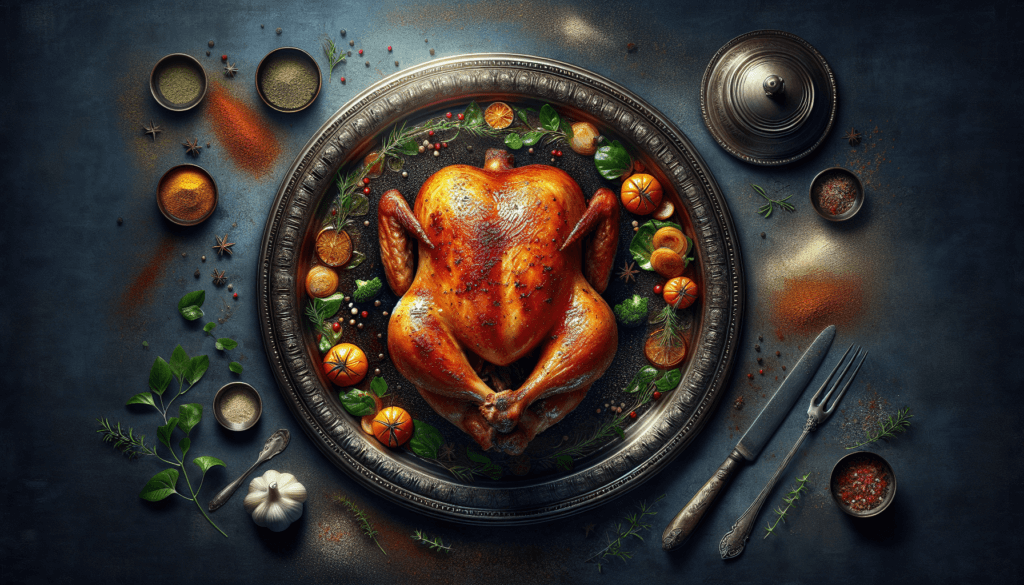
Achieving Crispy Skin
The skin of the roast chicken is often the highlight of the dish. Here are some tips to achieve that coveted crispy skin.
Proper Drying of the Chicken
Before roasting, it’s important to ensure the chicken’s skin is thoroughly dried. Pat the chicken dry with paper towels and let it air dry in the refrigerator for a few hours. This step removes excess moisture and allows the skin to crisp up during cooking.
Applying Oil or Butter
Coating the chicken skin with a thin layer of oil or melted butter helps to promote browning and crispy skin. Be sure to rub the oil or butter evenly over the entire chicken, including the legs and wings.
Roasting at High Temperature
To achieve crispy skin, consider starting the chicken at a high temperature (around 425°F or 220°C) for the first 15-20 minutes, then lowering the temperature to continue cooking. The initial high heat helps to render the fat and crisp up the skin, while the lower heat ensures the chicken cooks through evenly.
Resting and Carving
Allowing your roast chicken to rest before carving is just as important as the cooking process itself.
Allowing the Chicken to Rest
Once your chicken is cooked, remove it from the oven and let it rest for about 10-15 minutes before carving. This resting period allows the juices to redistribute, resulting in a more tender and moist chicken.
Carving the Chicken
When it’s time to carve your roast chicken, start by removing the wings and legs, followed by the breast meat. Use a sharp knife and steady strokes to ensure clean and even slices. Serve immediately and enjoy!

Accompaniments and Serving
The perfect roast chicken deserves equally delightful accompaniments and a beautiful presentation.
Choosing Side Dishes
When serving roast chicken, consider pairing it with complementary side dishes. Classic options include roasted potatoes, steamed vegetables, or a fresh salad. Mashed potatoes, roasted root vegetables, or a creamy risotto are also fantastic choices. Choose sides that complement the flavors of your roasted chicken and create a balanced and satisfying meal.
Presentation Tips
Presenting your roast chicken in an appealing way can elevate the dining experience. Arrange the carved chicken pieces on a platter, garnish with fresh herbs, and drizzle with some of the pan juices or gravy. Consider serving it alongside colorful vegetables or on a bed of fluffy couscous. A well-presented roast chicken is not only a feast for the taste buds but also a feast for the eyes.
Tips and Troubleshooting
As with any cooking endeavor, it’s helpful to be armed with some tips and troubleshooting advice to ensure everything goes smoothly.
Using a Meat Thermometer
Investing in a good-quality meat thermometer is a wise decision when roasting chicken. This tool will help you accurately gauge the internal temperature and ensure your chicken is cooked to perfection. A meat thermometer takes the guesswork out of determining doneness and eliminates any concerns about undercooking or overcooking.
Dealing with Dry Chicken
While all the steps outlined in this article are designed to prevent dry chicken, it can still happen occasionally. If your chicken turns out dry, consider serving it with a flavorful sauce or gravy to add moisture. Additionally, using a meat thermometer to achieve the ideal internal temperature and avoiding overcooking can greatly reduce the chances of dry chicken.
Common Mistakes to Avoid
To avoid potential mishaps or disappointing results, it’s helpful to be aware of common mistakes when making roast chicken. Some common mistakes include not properly seasoning the chicken, not allowing it to rest before carving, and using excessively high temperatures for extended periods. By following the tips outlined in this article and being mindful of these mistakes, you can ensure a delicious and successful roast chicken every time.
In conclusion, making the perfect roast chicken involves careful selection, preparation, and cooking techniques. By choosing the right chicken, seasoning it well, and cooking it with proper timing and temperature, you can create a roast chicken that is juicy, flavorful, and tender. With the tips and steps outlined in this article, you’ll be on your way to achieving roast chicken perfection. So go ahead, gather your ingredients, and start roasting your way to a memorable and satisfying meal.

